Experimental and Numerical Investigation of Joints for a Pultruded Fiber-Reinforced Polymer Truss
Abstract
1. Introduction
2. Materials and Methods
2.1. Materials
2.2. Methods
2.2.1. Double-Lap Direct Shear Test of Bolted GFRP Plates
Specimen Design of Double-Lap Direct Shear Test
Construction of Double-Lap Direct Shear Test Specimens
Data Acquisition of Double-Lap Direct Shear Test
2.2.2. Full-Scale Test of GFRP Pultruded Profile Truss Joints
Specimen Design of Full-Scale Test of GFRP Pultruded Profile Truss Joints
Data Acquisition of Full-Scale Test of GFRP Pultruded Profile Truss Joints
3. Results and Analysis of Double-Lap Shear Test
3.1. Failure Mode and Load Response of Double-Lap Direct Shear Test
3.2. Parametric Study of Double-Lap Direct Shear Test
3.2.1. Number of Bolts
3.2.2. Width of Plate
3.2.3. Edge Distance of Plate
3.2.4. Thickness of Plate
3.2.5. Adhesive
3.3. Numerical Simulation of Double-Lap Direct Shear Test
3.3.1. Configuration of Finite Element Model of Double-Lap Direct Shear Test
3.3.2. Comparison between FE Model and Experimental Results of Double-Lap Direct Shear Test
3.3.3. Analysis of Progressive Failure of Double-Lap Direct Shear Test Specimens
4. Results and Analysis of Full-Scale GFRP Joint Test
4.1. Tests Results and Observations of Full-Scale GFRP Joint Test
4.2. Failure Modes of Full-Scale GFRP Joint Test
5. Comparison between Double-Lap Direct Shear Test and Full-Scale GFRP Joint Test
6. Conclusions
- The peak load of the specimen with the proposed integrated gusset plate is 62% higher than the bolted one, and 38.8% higher than the typical gusset plate joint. As a comparison, the typical gusset plate can delay the formation of initial cracks and substantially reduce cracks, but it does not significantly improve the bearing capacity of joints.
- The bolted–bonded hybrid connection has 50% higher shear stiffness and 27% higher ductility compared with bolted joints, so the bolted–bonded hybrid connection is recommended to be employed together with the proposed integrated gusset plate.
- Bearing failure is the primary failure mode for most specimens. A crack formed at the 45° direction around the hole and propagated along the pultrusion direction until failure. It is recommended that more fibers shall be added to the transversal direction of the FRP members to be connected.
- Compared with bolted GFRP connections, the failure of GFRP pultruded profile truss joints is similar to the phenomenon in practical engineering of GFRP truss structures. The double-lap direct shear test specimen can represent the loading transferring from vertical and diagonal chords to the gusset plates and horizontal truss members.
- This research showed the advantages of using integrated gusset plates of the joints of the GFRP truss. It should be noted that GFRP can be used in field applications to replace the steel gusset plate used in this experiment considering durability requirements.
Author Contributions
Funding
Institutional Review Board Statement
Informed Consent Statement
Data Availability Statement
Acknowledgments
Conflicts of Interest
Nomenclature
| e | end distance of bolted pultruded GFRP specimen; |
| FRP | fiber-reinforced polymer; |
| GFRP | glass fiber-reinforced polymer; |
| IGP | integrated gusset plate; |
| l | length of pultruded GFRP specimen; |
| p | longitudinal spacing of bolts; |
| t | thickness of pultruded GFRP specimen; |
| w | width of pultruded GFRP specimen; |
| φ | hole diameter; |
| Pbolt | ultimate load of a single bolt; |
| Pu | load at the ultimate point; |
| Pcr | load at the initial cracking point; |
| Pd1 | load at the stiffness degradation starting point; |
| Pd2 | load at the stiffness degradation end point; |
| Pmax | load at the peak point; |
| δcr | displacement at the initial cracking point; |
| δd1 | displacement at the stiffness degradation starting point; |
| δd2 | displacement at the stiffness degradation end point; |
| δmax | displacement at the peak point; |
| δu | displacement at the ultimate point. |
References
- Camanho, P.; Matthews, F. Stress analysis and strength prediction of mechanically fastened joints in FRP: A review. Compos. Part A Appl. Sci. Manuf. 1997, 28, 529–547. [Google Scholar] [CrossRef]
- Feo, L.; Marra, G.; Mosallam, A. Stress analysis of multi-bolted joints for FRP pultruded composite structures. Compos. Struct. 2012, 94, 3769–3780. [Google Scholar] [CrossRef]
- Li, C.; Guo, R.; Xian, G.; Li, H. Innovative compound-type anchorage system for a large-diameter pultruded carbon/glass hybrid rod for bridge cable. Mater. Struct. 2020, 53, 73. [Google Scholar] [CrossRef]
- Li, C.; Yin, X.; Liu, Y.; Guo, R.; Xian, G. Long-term service evaluation of a pultruded carbon/glass hybrid rod exposed to elevated temperature, hydraulic pressure and fatigue load coupling. Int. J. Fatigue 2020, 134, 105480. [Google Scholar] [CrossRef]
- Wang, Z.; Zhao, X.; Xian, G.; Wu, G.; Singh Raman, R.; Al-Saadi, S. Durability study on interlaminar shear behaviour of basalt-, glass-and carbon-fibre reinforced polymer (B/G/CFRP) bars in seawater sea sand concrete environment. Constr. Build. Mater. 2017, 156, 985–1004. [Google Scholar] [CrossRef]
- Ferdous, W.; Manalo, A.; Salih, C.; Yu, P.; Abousnina, R.; Heyer, T.; Schubel, P. Behaviour of polymer filled composites for novel polymer railway sleepers. Polymers 2021, 13, 1324. [Google Scholar] [CrossRef]
- Al-Fakher, U.; Manalo, A.; Ferdous, W.; Alajarmeh, O.; Aravinthan, T.; Zhuge, Y.; Bai, Y.; Edoo, A. Shear behaviour of hollow precast concrete-composite structures. Mater. Struct. 2021, 54, 84. [Google Scholar] [CrossRef]
- Feng, P.; Wang, J.; Wang, Y.; Loughery, D.; Niu, D. Effects of corrosive environments on properties of pultruded GFRP plates. Compos. Part B Eng. 2014, 67, 427–433. [Google Scholar] [CrossRef]
- Feng, P.; Li, Z.; Wang, J.; Liu, T. Novel joint for pultruded FRP beams and concrete-filled FRP columns: Conceptual and experimental investigations. Compos. Struct. 2022, 287, 115339. [Google Scholar] [CrossRef]
- Hizam, R.; Manalo, A.; Karunasena, W.; Bai, Y. Behaviour of pultruded GFRP truss system connected using through-bolt with mechanical insert. Compos. Part B Eng. 2019, 168, 44–57. [Google Scholar] [CrossRef]
- Imperiale, V.; Cosentino, E.; Weaver, P.; Bond, I. Compound joint: A novel design principle to improve strain allowables of FRP composite stringer run-outs. Compos. Part A Appl. Sci. Manuf. 2010, 41, 521–531. [Google Scholar] [CrossRef]
- Zou, X.; Wang, J. Experimental study on joints and flexural behavior of FRP truss-UHPC hybrid bridge. Compos. Struct. 2018, 203, 414–424. [Google Scholar] [CrossRef]
- Fang, H.; Xu, C.; Sun, H.; Liu, W. Experiment on bearing capacity of bolted joints for pultruded composite square profile. Acta Mater. Compos. Sin. 2014, 31, 809–817. (In Chinese) [Google Scholar]
- Ma, Y.; Zhao, Q. Analysis of the bonded bolted hybrid composite joints’ carrying capacity. Acta Mater. Compos. Sin. 2011, 28, 225–230. (In Chinese) [Google Scholar]
- Ju, S.; Jiang, D.; Shenoi, R.; Xiao, J. Flexural properties of lightweight FRP composite truss structures. J. Compos. Mater. 2011, 45, 1921–1930. [Google Scholar] [CrossRef]
- McCarthy, C.; McCarthy, M.; Lawlor, V. Progressive damage analysis of multi-bolt composite joints with variable bolt-hole clearances. Compos. Part B Eng. 2005, 36, 290–305. [Google Scholar] [CrossRef]
- Keller, T.; Bai, Y.; Vallée, T. Long-term performance of a glass fiber-reinforced polymer truss bridge. J. Compos. Constr. 2007, 11, 99–108. [Google Scholar] [CrossRef]
- Keller, T.; Schaumann, E.; Vallée, T. Flexural behavior of a hybrid FRP and lightweight concrete sandwich bridge deck. Compos. Part A Appl. Sci. Manuf. 2007, 38, 879–889. [Google Scholar] [CrossRef]
- Russo, S. First investigation on mixed cracks and failure modes in multi-bolted FRP plates. Compos. Struct. 2016, 154, 17–30. [Google Scholar] [CrossRef]
- Lu, Z.; Yang, Q.; Lin, J. Study on influence of adhesive layer size on performance for single-lap bonding joint. China Adhes. 2009, 18, 1–3. (In Chinese) [Google Scholar]
- Yang, C.; Huang, H.; Tomblin, J.; Sun, W. Elastic-plastic model of adhesive-bonded single-lap composite joints. J. Compos. Mater. 2004, 38, 293–309. [Google Scholar] [CrossRef]
- Khashaba, U.; Sallam, H.; Al-Shorbagy, A.; Seif, M. Effect of washer size and tightening torque on the performance of bolted joints in composite structures. Compos. Struct. 2006, 73, 310–317. [Google Scholar] [CrossRef]
- Chishti, M.; Wang, C.; Thomson, R.; Orifici, A. Numerical analysis of damage progression and strength of countersunk composite joints. Compos. Struct. 2012, 94, 643–653. [Google Scholar] [CrossRef]
- Russo, S. On failure modes and design of multi-bolted FRP plate in structural joints. Compos. Struct. 2019, 218, 27–38. [Google Scholar] [CrossRef]
- Sun, H.; Chang, F.; Qing, X. The response of composite joints with bolt-clamping loads, part I: Model development. J. Compos. Mater. 2002, 36, 47–67. [Google Scholar] [CrossRef]
- Sun, H.; Chang, F.; Qing, X. The response of composite joints with bolt-clamping loads, part II: Model verification. J. Compos. Mater. 2002, 36, 69–92. [Google Scholar] [CrossRef]
- Wu, Z.; Islam, S.; Said, H. A three-parameter bond strength model for FRP-concrete interface. J. Reinf. Plast. Compos. 2009, 28, 2309–2323. [Google Scholar] [CrossRef]
- Yang, K.; Bai, Y.; Ding, C.; Kong, S. Comparative study on mechanical performance of bolted joints with steel and fibre reinforced polymer bolts. J. Build. Eng. 2021, 41, 102457. [Google Scholar] [CrossRef]
- Gu, Y. Strength Analysis and Influencing Factors of Mechanical Joints of Composite Materials. Ph.D. Thesis, Northwestern Polytechnical University, Xi’an, China, 2017. (In Chinese). [Google Scholar]
- Wu, C.; Zhang, Z.; Xu, N.; Tan, L. Experimental study on the group effect of GFRP-timber bolted connection in tension. China Civ. Eng. J. 2021, 54, 38–48. (In Chinese) [Google Scholar]
- Wu, C.; Bai, Y.; Mottram, J. Effect of elevated temperatures on the mechanical performance of pultruded FRP joints with a single ordinary or blind bolt. J. Compos. Constr. 2016, 20, 04015045. [Google Scholar] [CrossRef]
- Abdelkerim, D.; Wang, X.; Ibrahim, H.; Wu, Z. Effect of Connection Techniques on the Static and Fatigue Performance of Pultruded Basalt FRP Multibolted Joints. J. Compos. Constr. 2020, 24, 04020046. [Google Scholar] [CrossRef]
- Okutan, B.; Karakuzu, R. The strength of pinned joints in laminated composites. Compos. Sci. Technol. 2003, 63, 893–905. [Google Scholar] [CrossRef]
- Chen, S. Experimental study on mechanical properties of GFRP pedestrian truss bridge. Ph.D. Thesis, Southeast University, Nanjing, China, 2017. (In Chinese). [Google Scholar]
- Ascione, F.; Lamberti, M.; Razaqpur, A.; Spadea, S.; Malagic, M. Pseudo-ductile failure of adhesively joined GFRP beam-column connections: An experimental and numerical investigation. Compos. Struct. 2018, 200, 864–873. [Google Scholar] [CrossRef]
- Russo, S. Damage assessment of GFRP pultruded structural elements. Compos. Struct. 2013, 96, 661–669. [Google Scholar] [CrossRef]
- Russo, S. Shear and local effects in All-FRP bolted built-up columns. Adv. Struct. Eng. 2015, 18, 1227–1240. [Google Scholar] [CrossRef]
- Castellaro, S.; Russo, S. Dynamic characterization of an all-FRP pultruded construction. Compos. Struct. 2019, 218, 1–14. [Google Scholar] [CrossRef]
- Zhang, H.; Zhang, L.; Liu, Z.; Qi, S.; Zhu, Y.; Zhu, P. Numerical analysis of hybrid (bonded/bolted) FRP composite joints: A review. Compos. Struct. 2021, 262, 113606. [Google Scholar] [CrossRef]
- Mutsuyoshi, H.; Nguyen, H.; Zatar, W.; Ishihama, T. Flexural behavior of pultruded hybrid fiber-reinforced polymer I-beams with bonded-and-bolted splice joints. Transp. Res. Rec. 2016, 2592, 45–55. [Google Scholar] [CrossRef]
- Wu, C.; Feng, P.; Bai, Y. Comparative study on static and fatigue performances of pultruded GFRP joints using ordinary and blind bolts. J. Compos. Constr. 2015, 19, 04014065. [Google Scholar] [CrossRef]
- Coelho, A.; Mottram, J. A review of the behaviour and analysis of bolted connections and joints in pultruded fiber reinforced polymers. Mater. Des. 2015, 74, 86–107. [Google Scholar] [CrossRef]
- Turvey, G.; Cerutti, X. Flexural behaviour of pultruded glass fiber reinforced polymer composite beams with bolted splice joints. Compos. Struct. 2015, 119, 543–550. [Google Scholar] [CrossRef]
- Hai, N.; Mutsuyoshi, H. Structural behavior of double-lap joints of steel splice plates bolted/bonded to pultruded hybrid CFRP/GFRP laminates. Constr. Build. Mater. 2012, 30, 347–359. [Google Scholar] [CrossRef]
- Liu, T.; Feng, P.; Lu, X.; Yang, J.; Wu, Y. Flexural behavior of novel hybrid multicell GFRP-concrete beam. Compos. Struct. 2020, 250, 112606. [Google Scholar] [CrossRef]
- Liu, T.; Liu, X.; Feng, P. A comprehensive review on mechanical properties of pultruded FRP composites subjected to long-term environmental effects. Compos. Part B Eng. 2020, 191, 107958. [Google Scholar] [CrossRef]
- Standard of China Engineering Construction Standardization Association. Technical Specification for Structure of Pultruded Fiber Reinforced Polymer Composites; T/CECS 692-2020; China Construction Industry Press: Beijing, China, 2020. [Google Scholar]
- Zhu, Y.; Zhu, H.; Gribniak, V. Analyzing the Sample Geometry Effect on Mechanical Performance of Drilled GFRP Connections. Materials 2022, 15, 2901. [Google Scholar] [CrossRef] [PubMed]
- Hashin, Z. Failure criteria for unidirectional fiber composites. J. Appl. Mech. 1980, 47, 329–334. [Google Scholar] [CrossRef]

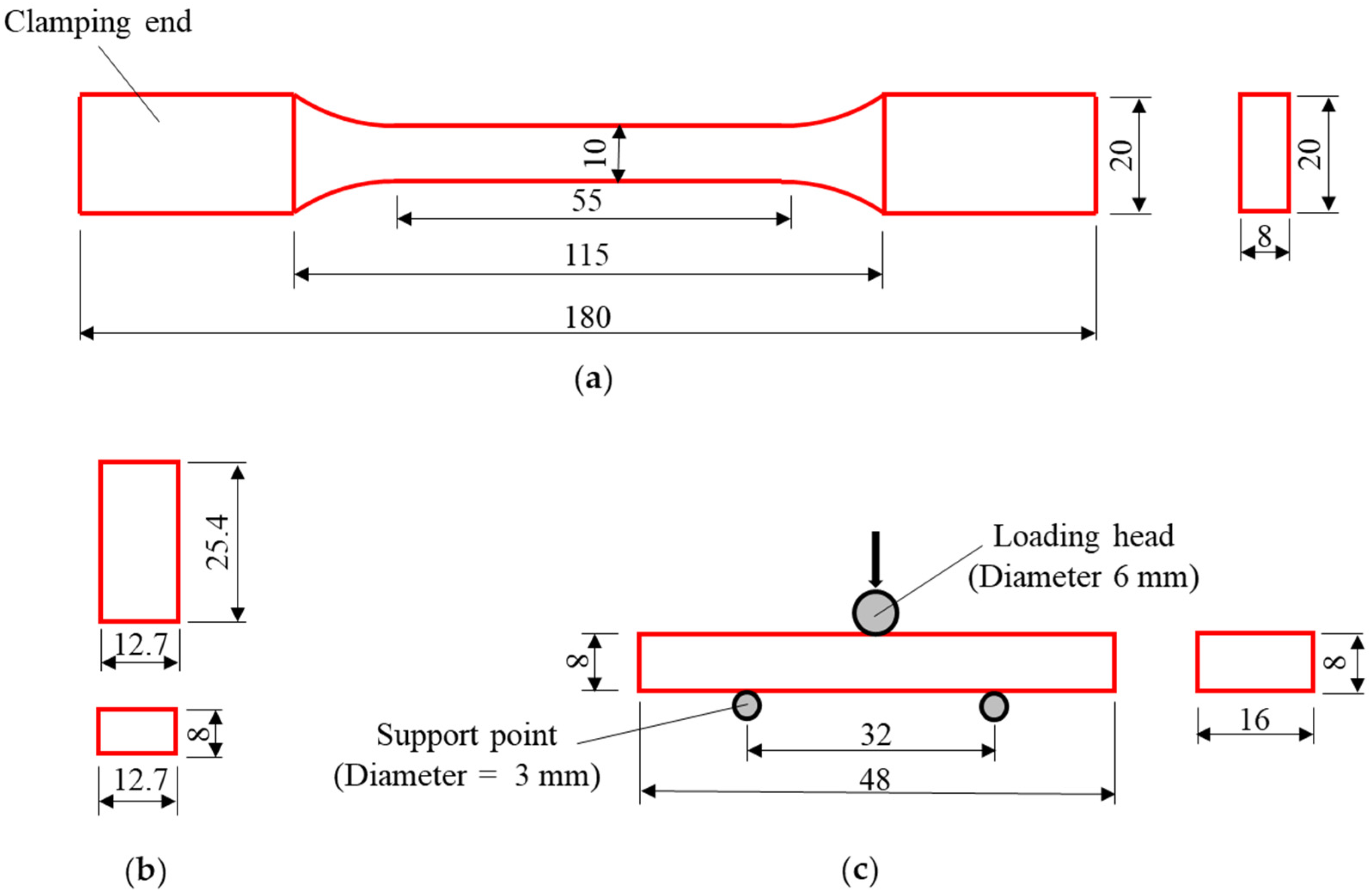

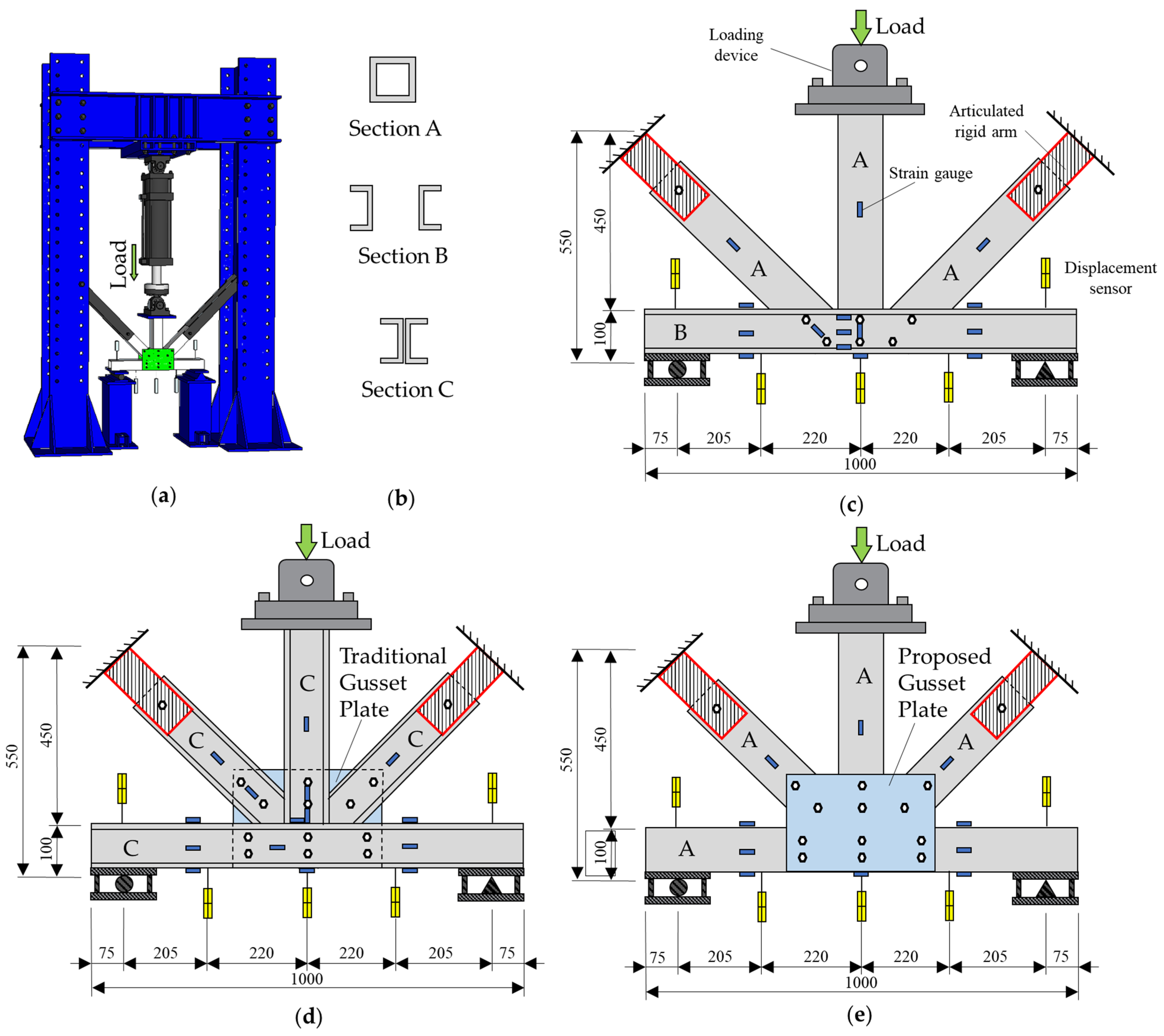


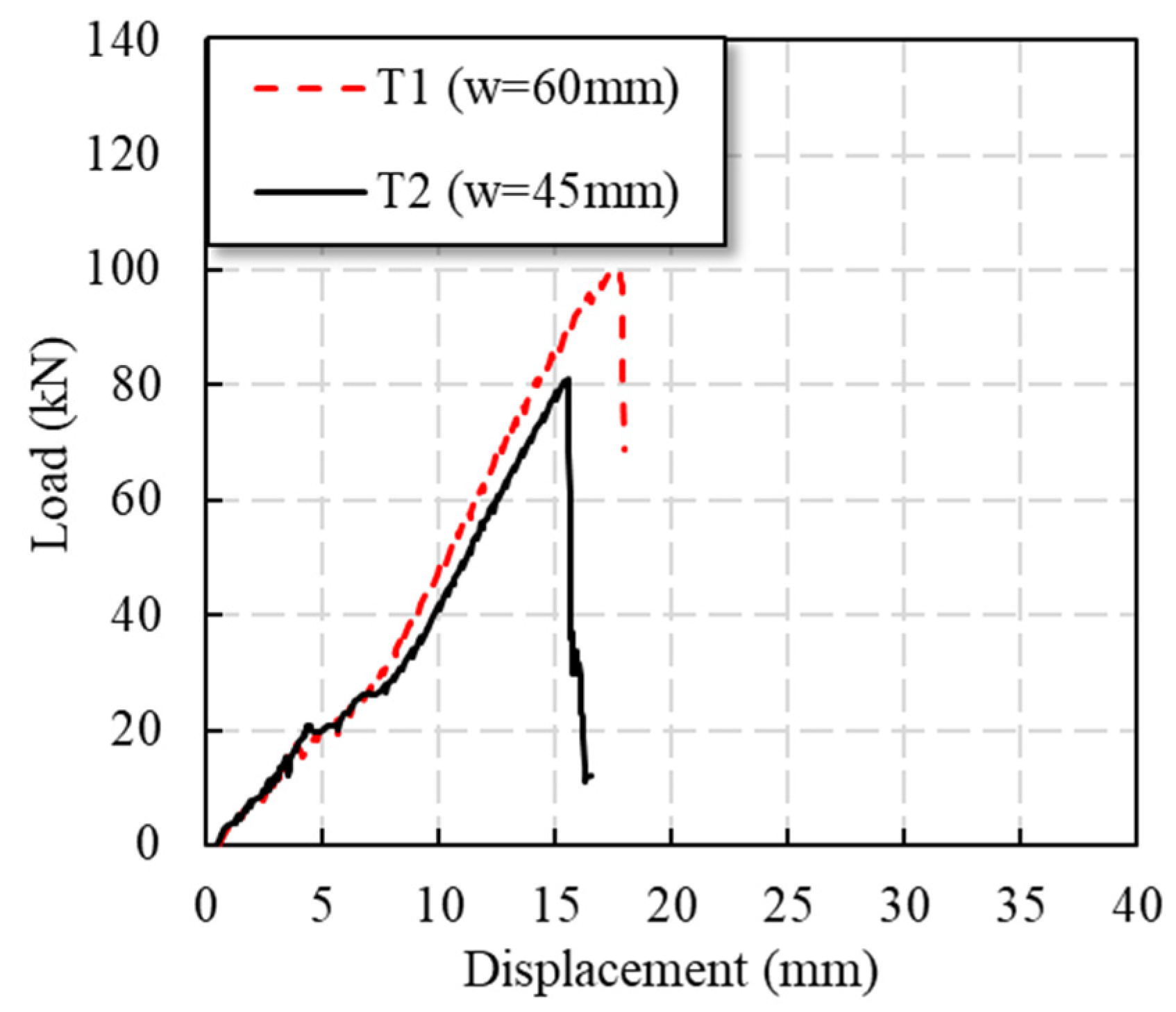

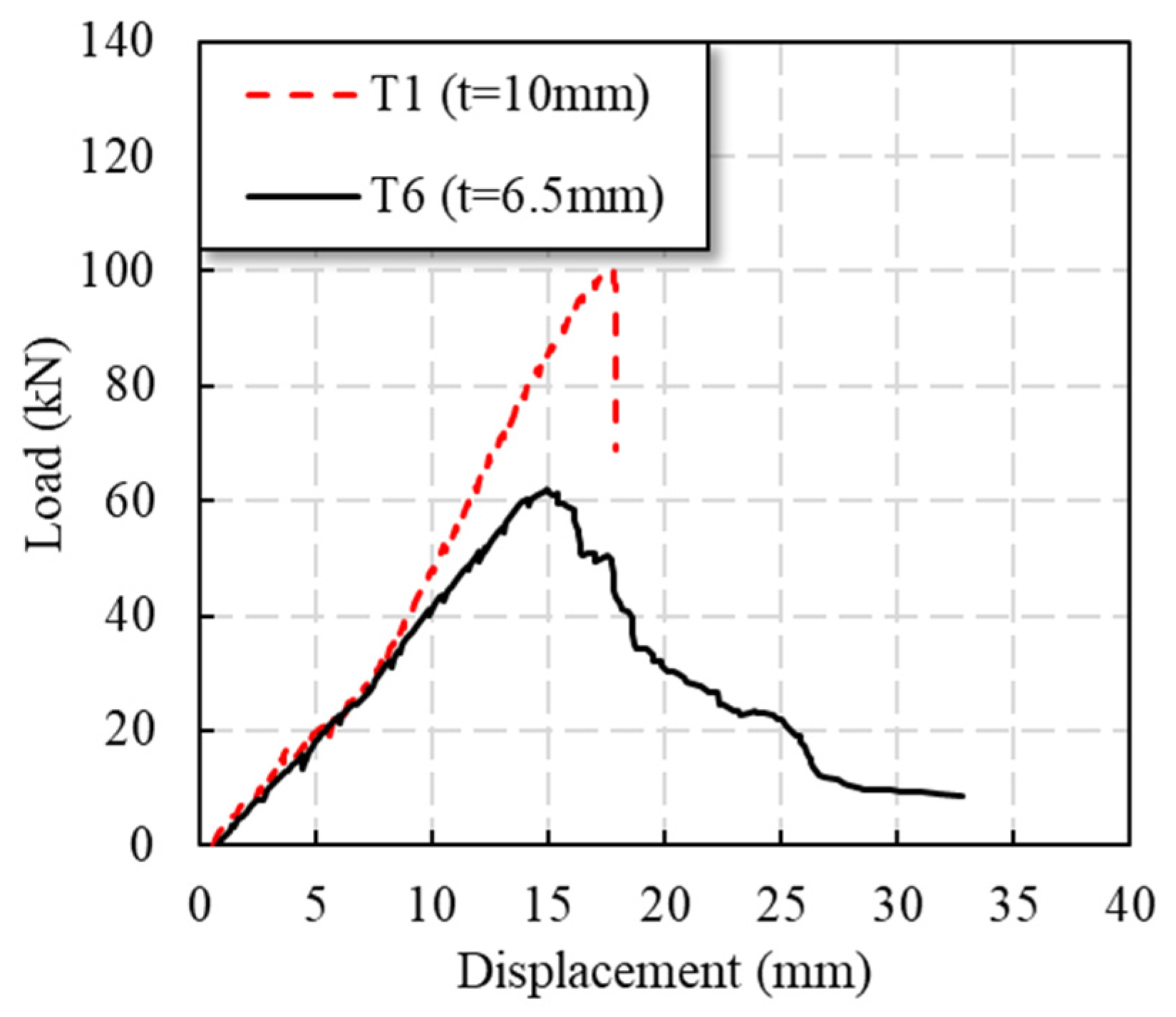
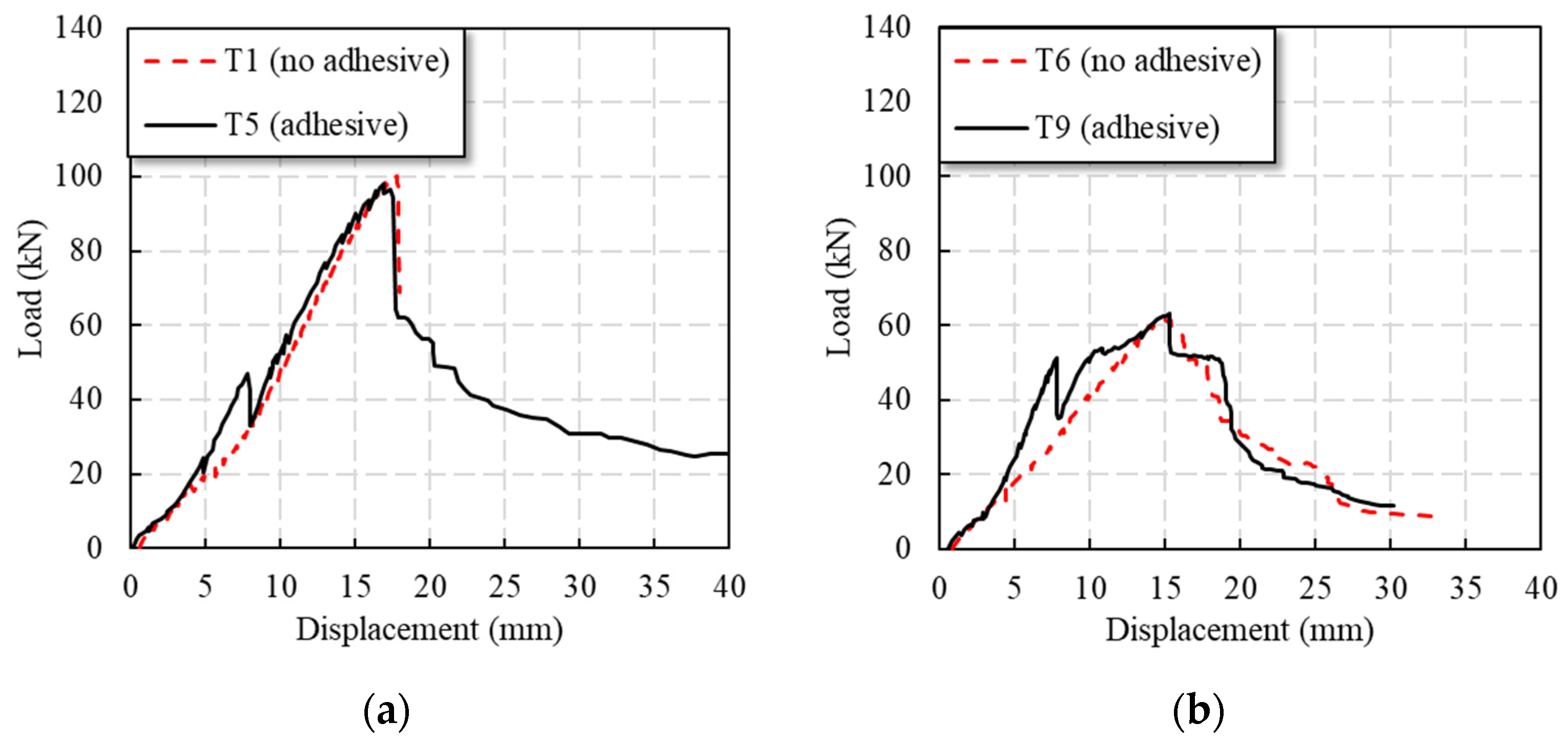


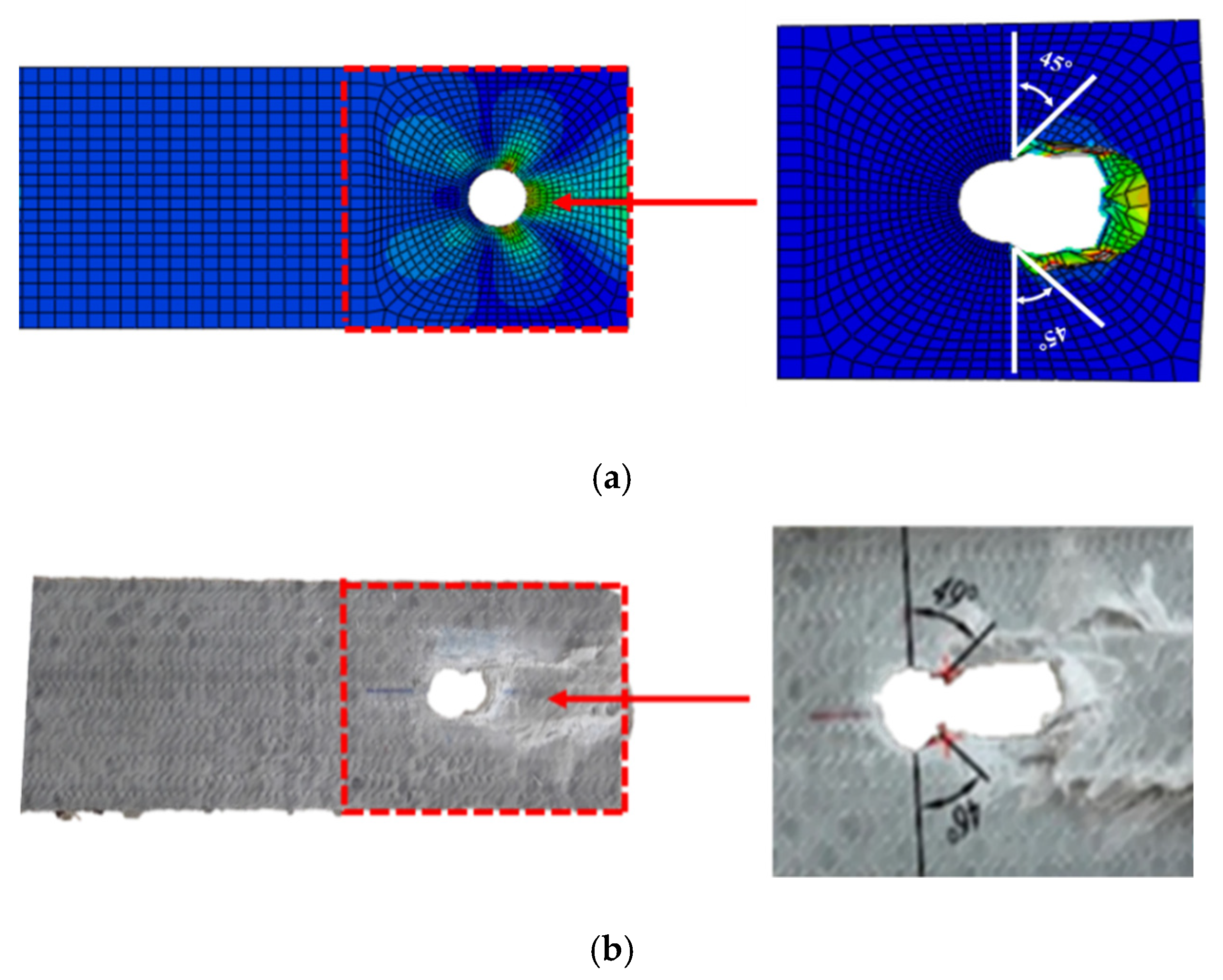
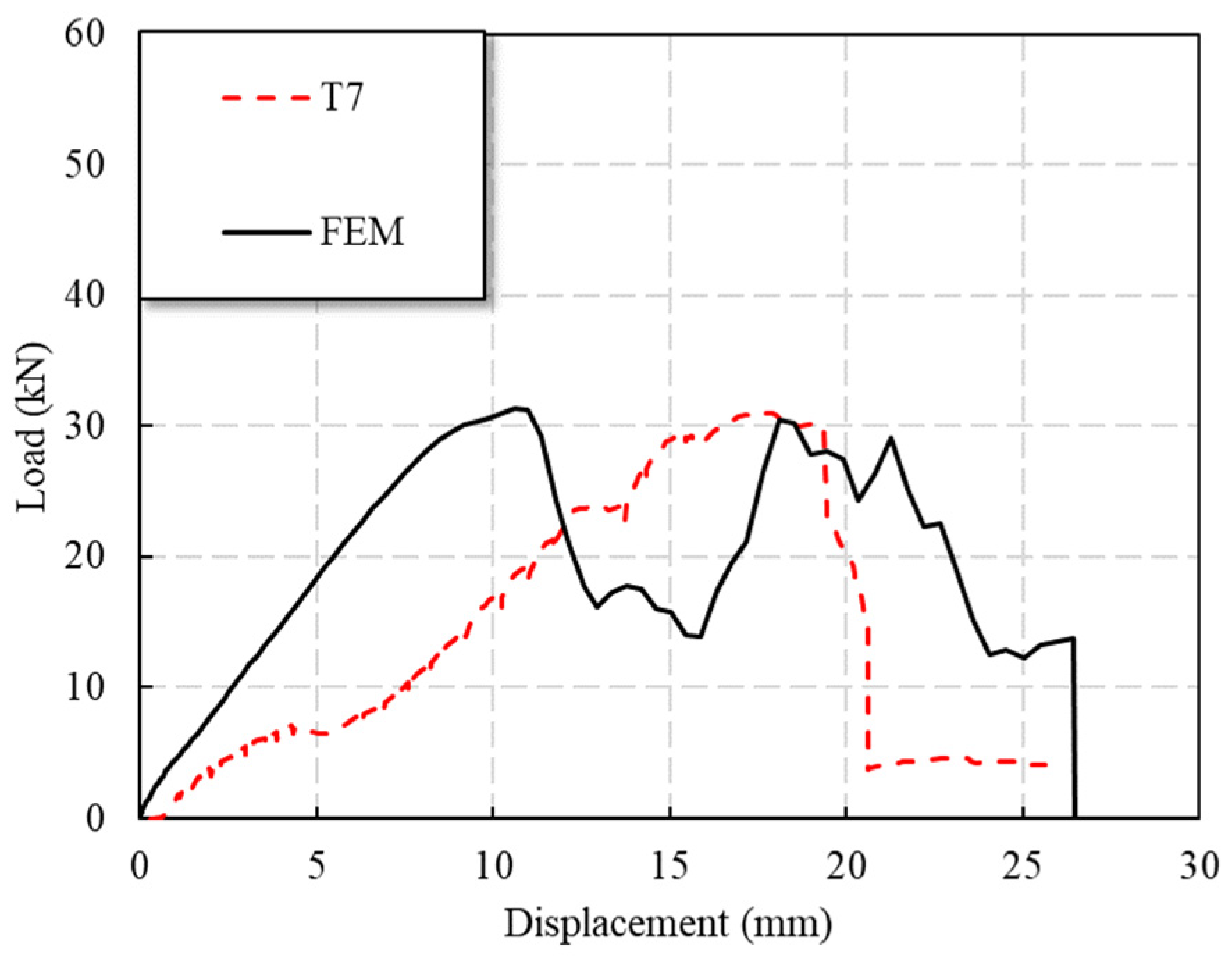
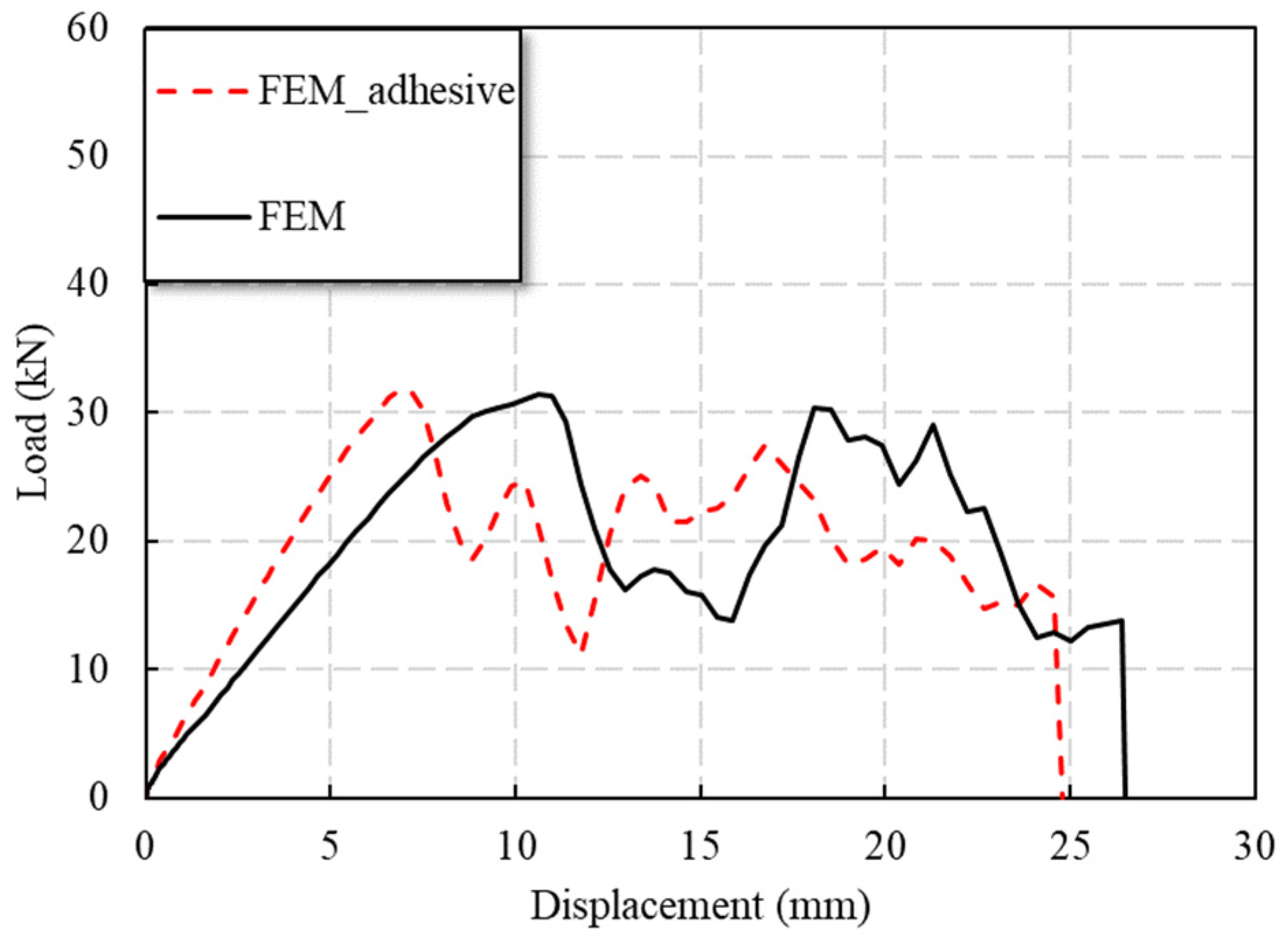
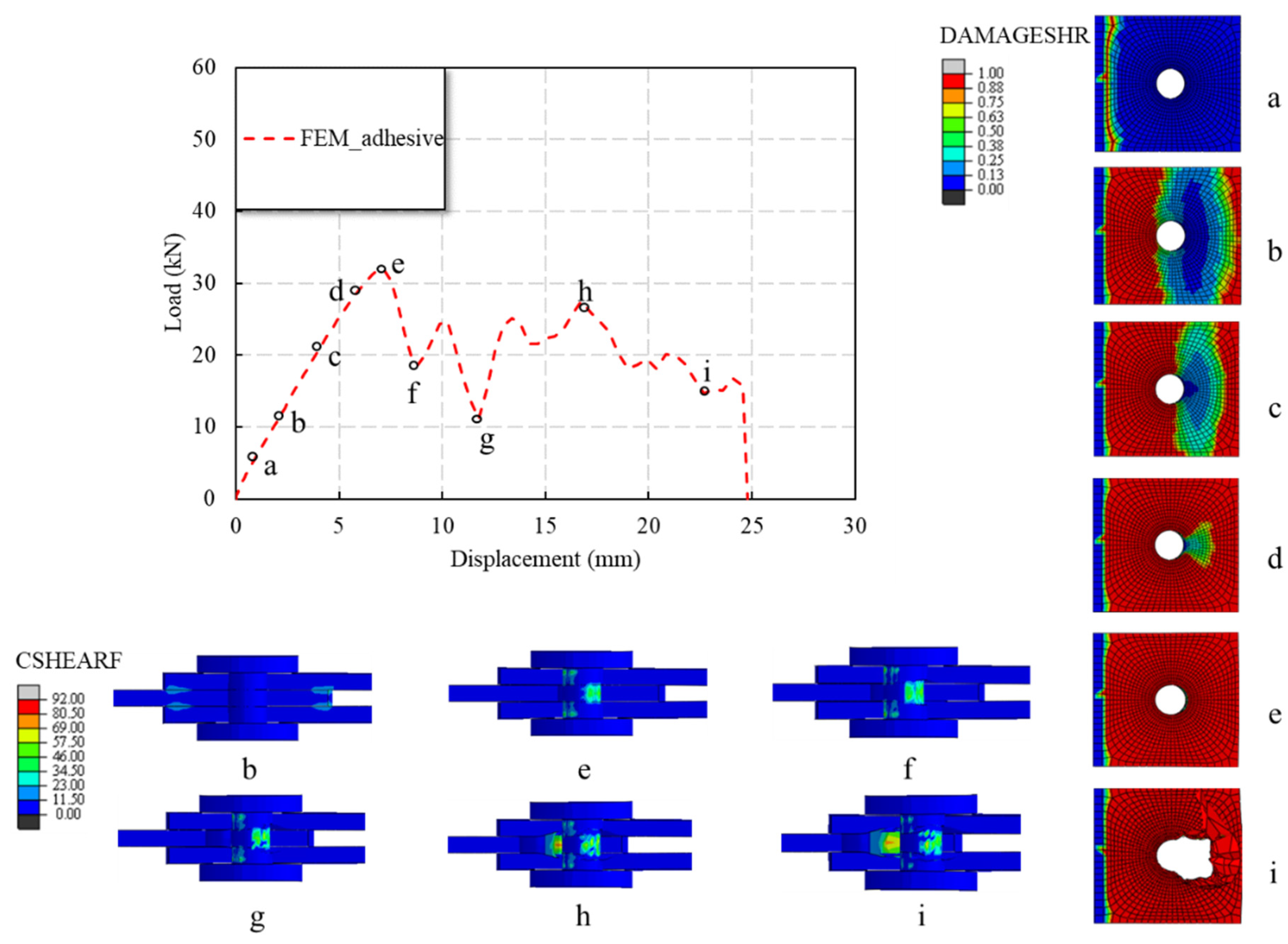

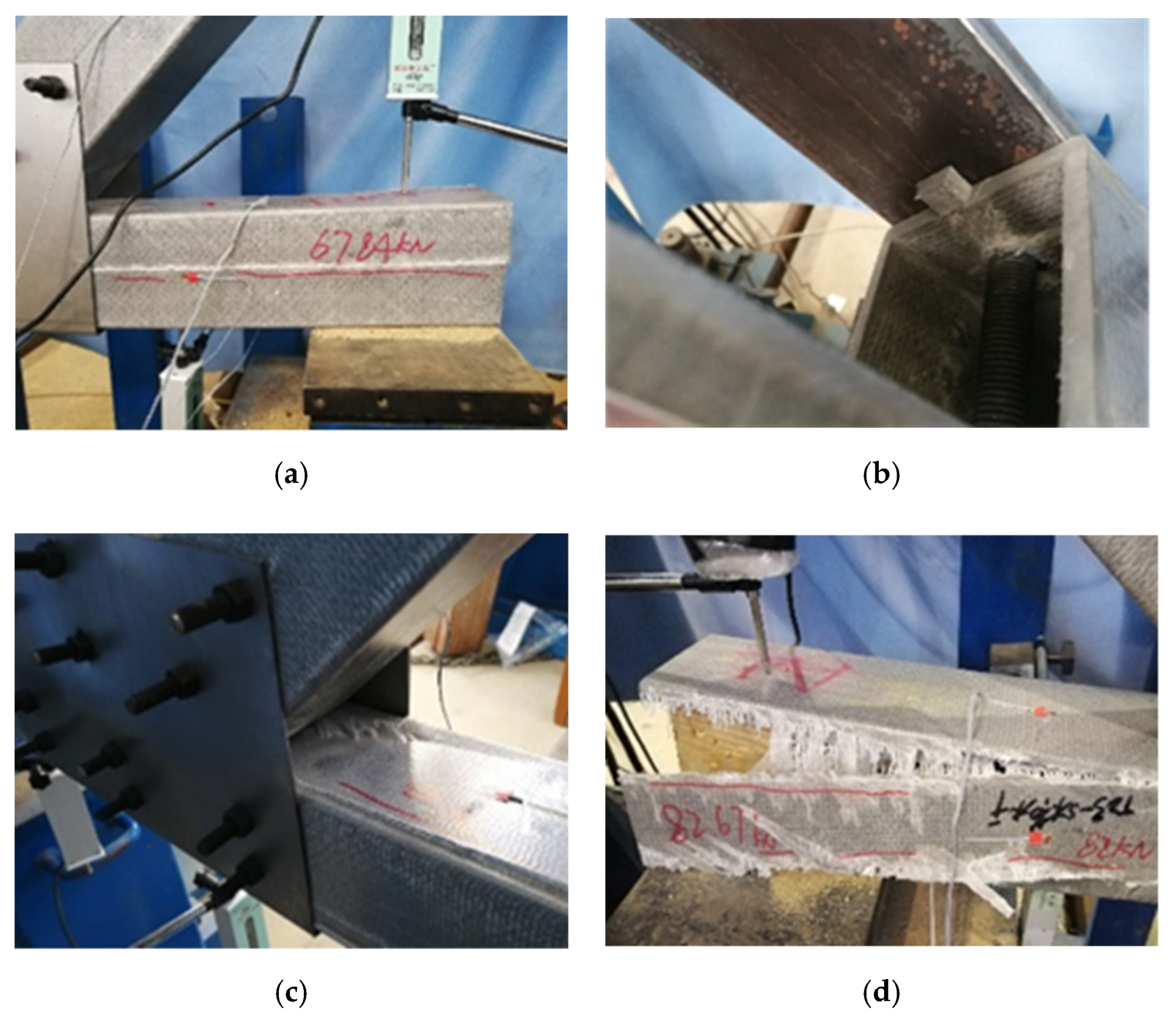
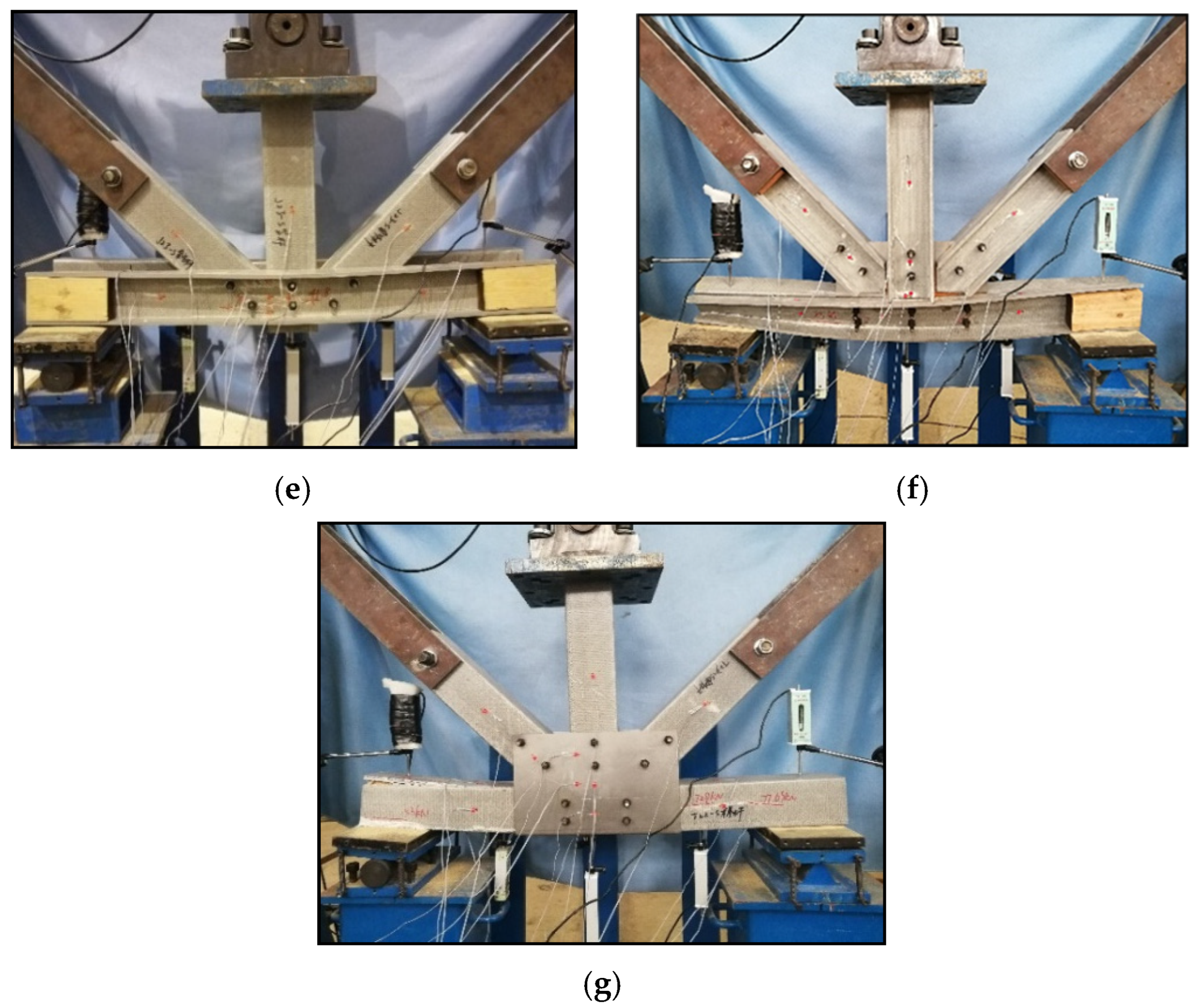



| Specimen ID | (mm) | (mm) | (mm) | (mm) | (mm) | (mm) | (kN) | (kN) |
|---|---|---|---|---|---|---|---|---|
| T1 | 350 | 60 | 10 | 70 | 50 | 12 | 100.7 | 50.4 |
| T2 | 350 | 45 | 10 | 70 | 50 | 12 | 80.8 | 40.4 |
| T3 | 350 | 60 | 10 | 70 | 40 | 12 | 89.3 | 44.7 |
| T4 | 350 | 60 | 10 | 70 | 60 | 12 | 94.5 | 47.3 |
| T5 | 350 | 60 | 10 | 70 | 50 | 12 | 97.9 | 48.9 |
| T6 | 350 | 60 | 6.5 | 70 | 50 | 12 | 62.1 | 31.0 |
| T7 | 350 | 60 | 6.5 | 70 | 50 | 12 | 35.2 | 35.2 |
| T8 | 420 | 60 | 6.5 | 70 | 50 | 12 | 65.5 | 21.8 |
| T9 | 350 | 60 | 6.5 | 70 | 50 | 12 | 63.2 | 31.6 |
| Failure Mode | Specimen | Typical Damage Diagram |
|---|---|---|
| Bearing | T1, T3, T4, T5, T7 |  |
| Tensile failure | T6, T9 |  |
| Shear-out | T2, T7, T8 |  |
| Specimen | Failure Mode | /kN | /mm | /kN | /mm | /kN | /mm | /kN | /mm | /kN | /mm |
|---|---|---|---|---|---|---|---|---|---|---|---|
| BJ | (a) (b) (d) | 33.75 | 15.36 | 17.43 | 7.25 | 22.53 | 10.48 | 45.78 | 22.44 | 36.33 | 38.73 |
| GP | (b) (c) (d) | 44.22 | 15.53 | 17.95 | 5.62 | 25.57 | 10.53 | 53.66 | 18.97 | 33.48 | 37.97 |
| IGP | (a) (b) (c) | 42.23 | 13.40 | 17.25 | 4.99 | 27.11 | 10.63 | 74.47 | 25.68 | 54.12 | 25.76 |
Publisher’s Note: MDPI stays neutral with regard to jurisdictional claims in published maps and institutional affiliations. |
© 2022 by the authors. Licensee MDPI, Basel, Switzerland. This article is an open access article distributed under the terms and conditions of the Creative Commons Attribution (CC BY) license (https://creativecommons.org/licenses/by/4.0/).
Share and Cite
Chen, Y.; Duan, M.; Zou, X.; Feng, Y.; Li, G. Experimental and Numerical Investigation of Joints for a Pultruded Fiber-Reinforced Polymer Truss. Polymers 2022, 14, 4810. https://doi.org/10.3390/polym14224810
Chen Y, Duan M, Zou X, Feng Y, Li G. Experimental and Numerical Investigation of Joints for a Pultruded Fiber-Reinforced Polymer Truss. Polymers. 2022; 14(22):4810. https://doi.org/10.3390/polym14224810
Chicago/Turabian StyleChen, Yiwei, Maojun Duan, Xingxing Zou, Yu Feng, and Guofen Li. 2022. "Experimental and Numerical Investigation of Joints for a Pultruded Fiber-Reinforced Polymer Truss" Polymers 14, no. 22: 4810. https://doi.org/10.3390/polym14224810
APA StyleChen, Y., Duan, M., Zou, X., Feng, Y., & Li, G. (2022). Experimental and Numerical Investigation of Joints for a Pultruded Fiber-Reinforced Polymer Truss. Polymers, 14(22), 4810. https://doi.org/10.3390/polym14224810







